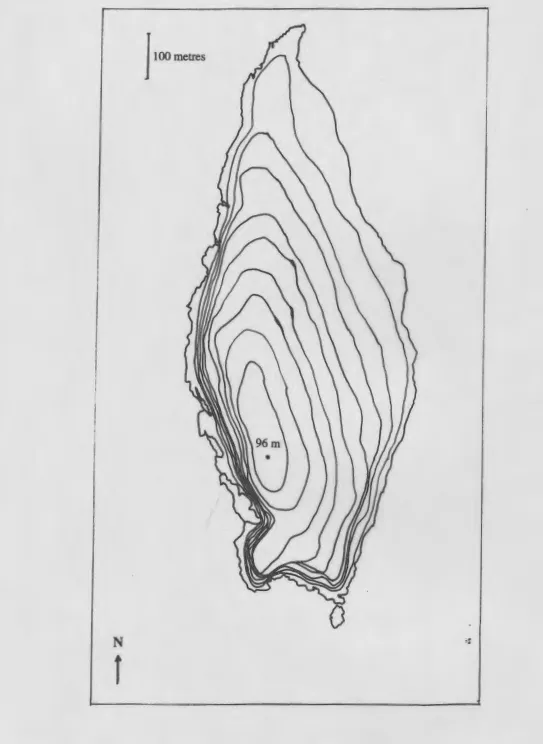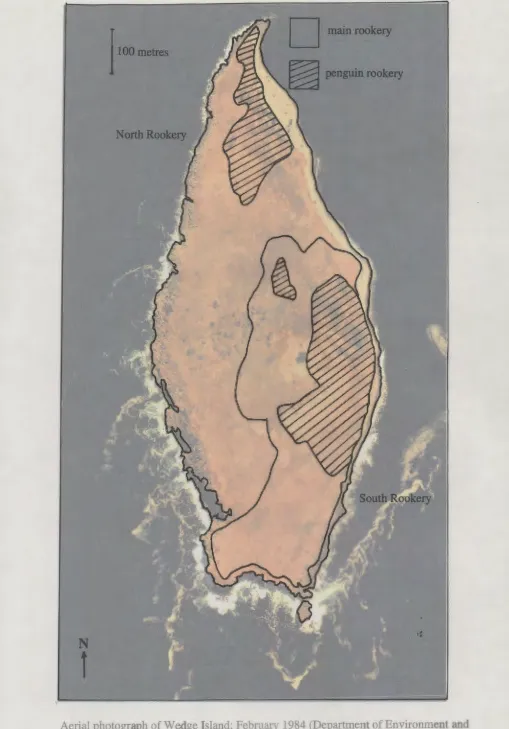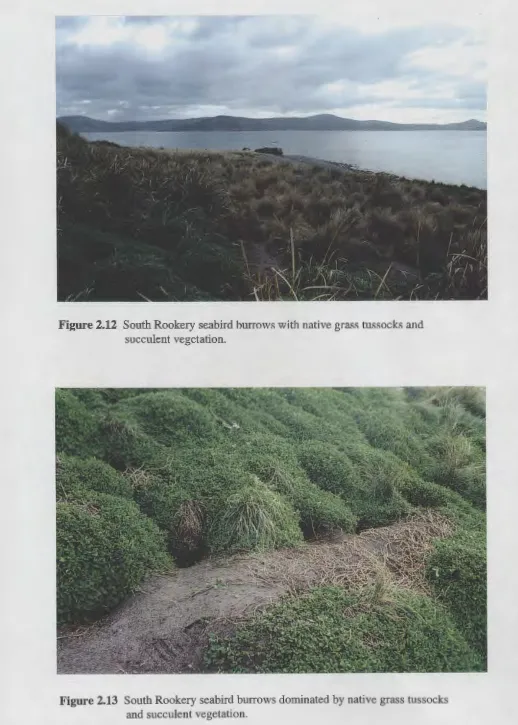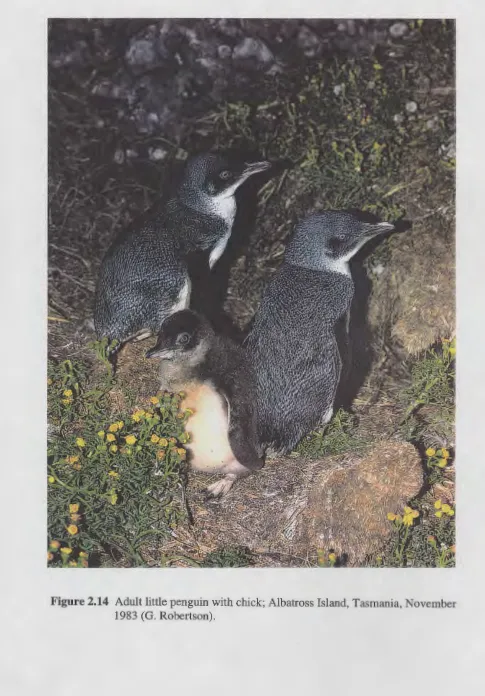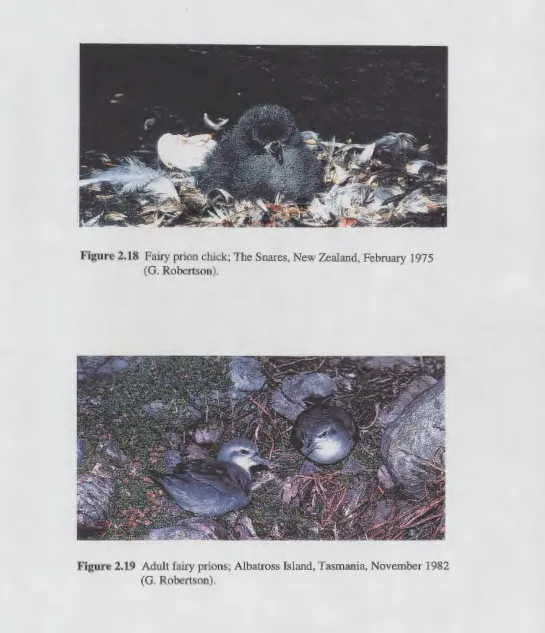The winter ecology of the feral cat, Felis catus (Linnaeus 1758), at
Wedge Island, Tasmania
by
Jay Chin Liang Beh, B.Sc
A thesis submitted to the Zoology Department,
University of Tasmania, in partial fulfilment of the
requirements for the Degree of Bachelor of Science with Honours
TABLE OF CONTENTS
SUMMARY
ACKNOWLEDGEMENTS
CHAPTER!:
General Introduction ... 1
Predatory impacts: evidence from islands ... 2
Australian offshore islands. . . 3
Aims of the study. . . 4
CHAPTER2:
Study site ... 5Vertebrate prey on Wedge Island ... 7
Little penguin Eudyptula minor... 8
Short-tailed shearwater Puffin us tenuirostris... 9
Fairy prion Pachyptila turtur ... 10
Tasmanian native hen Gallinula mortierii ... ... 11
Other vertebrate fauna ... 12
CHAPTER3:
Feral cats on Wedge Island: past and present ... 13Island background and history ... 13
Methods ... 14
Live trapping ... 14
Spotlighting ... 14
Results ... 15
Live trapping ... 15
Spotlighting ... 16
Data analysis ... 16
Discussion ... · ... 16
CHAPTER4:
Feral cat population: dietary analysis ... 18Introduction ... 18
Aims ... 19
Methods ... 19
Results ... 20
Scat collection ... 20
Scat analysis ... 20
Data analysis ... 23
Discussion ... 24
CHAPTERS:
Bird populations ... 27ACKNOWLEDGEMENTS
I would like to sincerely express my deep gratitude to both my supervisors, Mark Hindell and Othmar Buchmann for their unique supervision, encouragement, patience and expertise. My sincere thanks also extend to Sue Jones for her assistance with my research and also for her constant support and advice. I would also like to thank members of the Zoology Department technical staff for their help and support throughout the course of my research. Thanks go out to Barry Rumbold and Alan Dumphy who constantly met my supply needs and also to Richard Holmes, Adam Stephens, Wayne Kelly and Ron Mawby for getting me to and off Wedge Island throughout the year in all kinds of wonderful Tasmanian weather. Their constant good humour and logistic support was greatly appreciated.
CHAPTER!
General Introduction
The domestic or house cat Felis catus (Carnivora: Felidae) is usually believed to be
derived from the African or Arabian wildcat Felis sylvestris lybica (Randi and Ragni
1991, Bradshaw 1992). Circumstantial evidence suggests that domestication began about 8000 BP in the eastern Mediterranean (Zeuner 1958, le Brunet al. 1987) and
continued until 4000 BP in the Middle East and perhaps also in the valley of the Indus (Baldwin 1975, Ahmad et al. 1980). Paintings and sculptures of cats from the
Eighteenth Dynasty confirm that cats were fully domesticated and living in close association with humans in Egypt by 3600 BP (Clutton-Brock 1981, Serpell1988). Domestic cats spread slowly from Egypt, but occupied much of Europe prior to the spread of the Roman Empire (Waldren et al. 1984, Kitchener 1991). In the last 2000
years domestic cats have been transported actively on sailing vessels to most parts of the world (Lumpkin 1993), either for food, their ability to control ship-borne rodents or as pets (Dickman 1995).
Although initially confined to settled areas, cats in many parts of the Pacific region have established feral populations that persist in remote or little disturbed localities. In contrast to domestic cats which obtain most or all of the resources they need to survive and reproduce from humans, feral cats have little or no interaction with humans and maintain self perpetuating populations. In Australia, populations of feral cats were augmented in the nineteenth century by the planned release of thousands of cats outside of settled areas (Rolls 1969). Releases were made to control numbers of mice at gold digs in south-eastern and western Australia (Howitt 1855) and also in an attempt to control plagues of rabbits (Rolls 1969) and native rats (Bennett 1879) (Dickman 1995).
Until European colonisation of the Pacific region, Australia, New Zealand, Antarctica and the many Pacific islands contained no species of felids, and were relatively depauperate in medium sized species of carnivorous mammals (Flannery 1994). Hence the arrival of Felis catus probably represented an important ecological event. Recent studies of domestic cats in Australia and New Zealand have shown that many species of native vertebrates are killed by cats each year, and suggest that the impact of cats in settled areas is substantial (Fitzgerald 1988, Paton 1991 ). The impact of feral cats on native fauna has not been critically investigated, but numerous historical and circumstantial accounts suggest that cats can have large deleterious effects (Dickman 1993).
Predatory impact: evidence from islands
Because of their physical isolation, many islands off the coast of Australia and elsewhere in the Pacific region have been subject to little disturbance from human activities. Islands that have been isolated for long periods (i.e. pre-Pleistocene) often have taxa that are endemic to them, while many islands isolated by sea level rises at the end of the Pleistocene retain biota that disappeared from the adjacent mainland after the onset of European settlement. However, some islands have also suffered limited disturbance, such as the introduction of cats. Feral cats occur on at least 40 islands off the coast of Australia (Dickman 1992), seven off the coast ofNew Zealand (Veitch 1985) and several dozen elsewhere in the Pacific (King 1973, 1984). While
they are usually not the only agent of disturbance that has been introduced, cats may be the most obvious or important agent that can be identified. Changes in island faunas after the introduction of cats can provide compelling evidence of the impact of the latter (Dickman 1995).
Australian offshore islands
In the Australian region feral cats have caused or contributed to population declines and extinctions on many offshore islands (Appendix 1). Among the best documented case studies are the loss of brush tailed bettongs from St. Francis Island, South
Australia and the losses of several small and medium sized mammals from Dirk Hartog Island, Western Australia. In addition to these well documented studies, feral cats have been implicated strongly in losses of mammals and birds from Hermite Island in the Monte Bello group (Burbridge 1971) and probably also in the loss of the greater stick-nest rat Leporillus conditor from Reevesby Island in the Sir Joseph
Banks group (Robinson 1989). Some species of birds and seabirds seem to have fared better than mammals on Australian offshore islands, although the white faced storm petrel Pelagodroma marina has declined markedly on three islands (Appendix 1 ).
The exposed burrows, nocturnal activity and clumsy movements of this species on land perhaps increase its proneness to predation from feral cats.
Taken together, the studies summarised in Appendix 1 and 2 demonstrate that feral cats can decimate insular island populations of native mammals and birds. However it is more surprising that stable coexistence may apparently be possible between certain species and feral cats. For example, the golden bandicoot Isoodon auratus
disappeared from Hermite Island after the introduction of cats, but the ecologically similar southern brown bandicoot Isoodon obesulus persisted with feral cats on St.
Francis Island (Robinson and Smyth 1976) and occurs commonly with cats on
Kangaroo Island (Inns et al. 1979). Detailed ecological studies on insular species with
stable populations are sparse but suggest that some native species can coexist with feral cats if refuges are available.
The general stability of seabird populations on Australian offshore islands (Appendix 1) perhaps best reflects the effect of certain features of community type and structure. Different community types and structures could very well be the determining factor which shape the extent of feral cat predation and its corresponding impact on island populations. For example, seabird populations may be able to sustain relatively high levels of predation on islands, providing that immigration rates equal or exceed losses (Saunders and Rebeira 1985, 1986). Other modifying factors such as behavioural aspects, foraging and breeding patterns or even habitat preferences could either neutralise or enhance predation impacts by feral cats. Conversely, the population dynamics of local island fauna could represent limiting parameters governing feral cat ecology.
Aims of the study
This study examines the winter ecology of the feral cat Felis catus on Wedge Island in
the south-eastern region of Tasmania. The general aims of the project were to:
1. quantify the diet of the feral cat population over the winter months; 2. relate the quantified diet to prey availability and abundance during winter; 3. relate prey availability and abundance to reproductive condition of feral cats
throughout the winter months; and
4. determine the home ranges and spatial organisation of individuals in the feral cat population.
CHAPTER2
Study site
Wedge Island (43° 09'S, 147° 33'E) is located 1.25 kilometres off the Tasman Peninsula in the south-eastern region of Tasmania (Fig 2.1). The length of the island is approximately 1.3 kilometres from north to south, with a maximum width of0.55 kilometres, at mid-island. The area of the island is approximately 50 hectares (Fig. 2.2). Wedge Island is characterised by steep dolerite cliffs (igneous rock formations) framing the western border while large irregular boulder platforms/cliffs and rocky outcrops forming the north and southern ends of the island. The eastern shoreline consists of a level rocky shore, beginning at the northern extremity which extends to the cliffs at the south end. A ridge line runs in a north-south direction, with a peak of 96 metres above sea-level (Figure 2.2). Wedge Island possesses a temperate climate and experiences a wide range of weather conditions, with an average annual
temperature range of8.1 C to 14.7 C (Palmer's Lookout Weather Station, Bureau of Meteorology) and a recorded rainfall of797 mm in 149 raindays (Port Arthur Weather Station, Bureau of Meteorology).
Wedge Island is an important island rookery for nesting seabirds during the breeding season. These seabirds include little penguins (Eudyptula minor) and two species of petrels: short-tailed shearwaters (Puffinus tenuirostris) and fairy prions (Pachyptila
turtur). The island has two major rookeries, the North and South Rookery, which are
situated at opposite ends of the island (Fig. 2.3). The total area of the North Rookery is approximately 0.02 square kilometres, whereas the total area of the more extensive South Rookery is approximately 0.17 square kilometres. Both rookeries are utilised by petrels, fairy penguins and native hens; the North Rookery is almost exclusively used by penguins (Fig. 2.3). Juvenile muttonbirds are commercially harvested within a limited period on the island during the breeding season between 27th March and 30th April (Schodde 1986).
1100
metres0
N
[image:10.585.19.562.16.760.2]r
•
•
•
•
Aerial photograph of Wedge Island; February 1984 (Department of Environment and L;}nd Man ement)
I
I
•
•
•
[image:16.578.51.560.15.744.2]Aerial photograph of Wedge Island; February 1984 (Department of Environment and Lanrl "'"<>cgement)
•
•
•
[image:18.571.40.544.54.752.2]•
Figure 2.4 Northern end of Wedge Island, overlooking North Rookery and base
camp at north tip .
•
•
•
[image:19.573.28.563.38.735.2]•
Figure 2.6 Mid island ridge-line view towards southern end of Wedge Island; vegetation dominated by short sword grassfields and native grass tussocks .
•
[image:20.578.36.564.36.760.2]•
Figure 2.8 Cliff face at the southern tip of Wedge Island .
•
•
•
[image:21.577.9.564.38.746.2]•
Figure 2.10 View of South Rookery from eastern shoreline .
•
•
•
•
•
[image:22.579.46.564.39.764.2]•
Figure 2.12 South Rookery seabird burrows with native grass tussocks and
succulent vegetation .
Figure 2.13 South Rookery seabird burrows dominated by native grass tussocks
•
•
•
•
Figure 2.14 Adult little penguin with chick; Albatross Island, Tasmania, November [image:24.577.53.538.33.729.2]•
•
•
•
[image:26.580.18.563.26.758.2]•
•
•
[image:28.574.19.564.75.708.2]•
Figure 2.18 Fairy prion chick; The Snares, New Zealand, February 1975
(G. Robertson) .
Figure 2.19 Adult fairy prions; Albatross Island, Tasmania, November 1982
•
[image:30.579.14.565.47.749.2]•
Figure 2.15 Tasmanian native hens, Wedge Island .
•
I
.
•
[image:35.578.64.566.37.745.2]•
Figure 3.1 Feral cat caught by live trapping and sedated .
•
Figure 3.2 Feral cat identified by ear tattoo.
-•
[image:44.585.38.571.43.737.2]•
Figure 4.4 Remains of a short-tailed shearwater killed by feral cat.
•
•
•
•
•
[image:47.572.10.547.37.741.2]•
Figure 4.6 Skeletal remains of Tasmanian native hen killed by feral cat.
]100
metresD
0040
005D
0060
[image:74.596.23.581.13.758.2]N
1
Figure 7.1 Home range overlaps of adult male (006), adult female (004) and juvenile
•
•
•
•
Aerial phot L?ndM!l
ph of Wedge Island; February 1984 (Department of Environm
[image:76.585.10.565.12.737.2]m nt).
